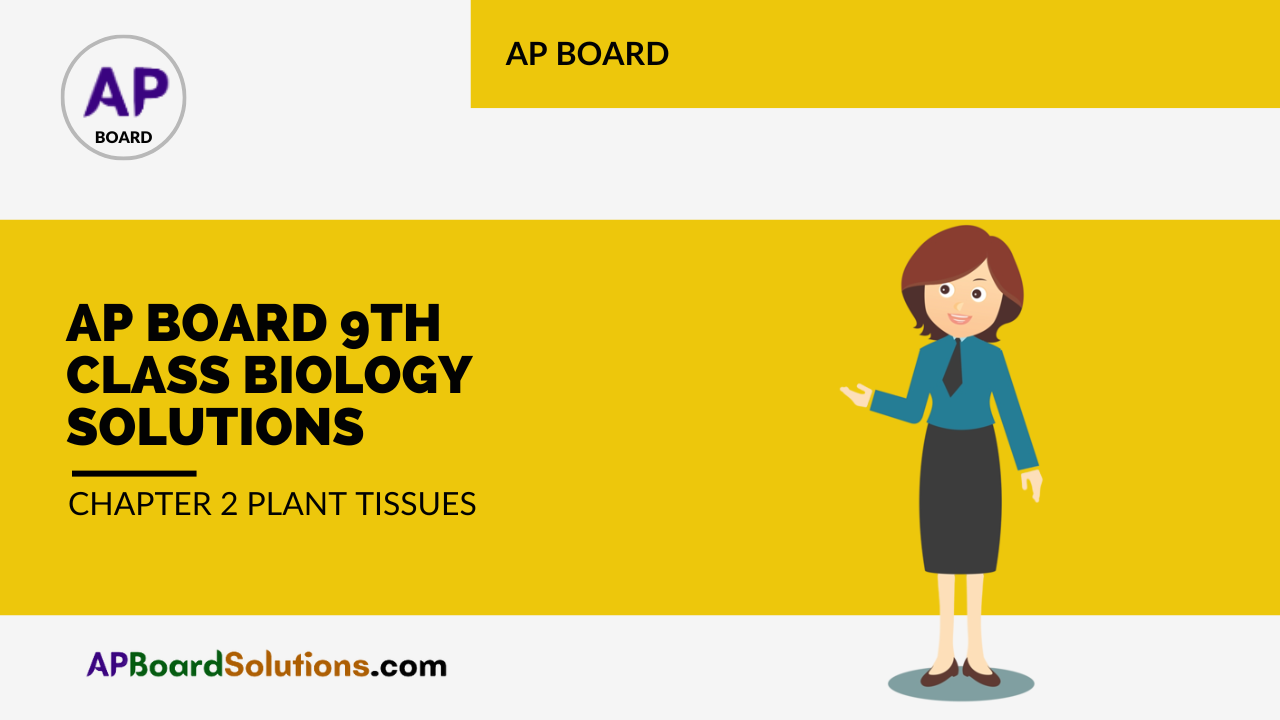AP State Syllabus AP Board 9th Class Biology Solutions Chapter 2 Plant Tissues Textbook Questions and Answers.
AP State Syllabus 9th Class Biology Solutions 2nd Lesson Plant Tissues
9th Class Biology 2nd Lesson Plant Tissues Textbook Questions and Answers
Improve Your Learning
Question 1.
Define the terms (AS 1)
A) Tissue
B) Meristematic tissue
C) Dermal tissue.
Answer:
A) Tissue :
Tissue is a group of cells similar in structure and performing similar functions.
B) Meristematic tissue :
Meristematic tissue is the dividing tissue present in the growing regions of the plant.
C) Dermal tissue :
Tissues that form outer coverings are called as dermal tissues. It gives protection to the plant.
![]()
Question 2.
Differentiate the following. (AS 1)
A) Meristematic tissue and Ground tissue :
| Meristematic tissue | Ground tissue |
| 1. Cells divide continuously. | 1. Cells do not divide and cannot derived from the meristem. |
| 2. It is a simple tissue. | 2. It is a simple or complex tissue. |
| 3. Cells are living. | 3. Cells may be living or dead. |
| 4. Dense cytoplasm is present in the cell. | 4. Thin cytoplasm is present in the cell. |
B) Apical Meristem and Lateral Meristem :
| Apical Meristem | Lateral Meristem |
| 1. Apical meristem is found in growing tips of root stem and apices of leaves. | 1. Lateral meristems are present around the edges in a lateral manner. |
| 2. It brings about growth in length of stems and roots. | 2. It rise the growth in diameter of the stem and root. |
C) Parenchyma and Collenchyma :
| Parenchyma | Collenchyma |
| 1. The cells of parenchyma are soft, thin walled and loosely packed. | 1. The cells of collenchyma are thick walled and compactly arranged. |
| 2. They store food, bears chloroplasts and contain larger cavities. | 2. They give mechanical strength in young tissue of stem. |
| 3. Cell wall is primary made up of cellulose. | 3. Cell wall has deposition of extra cellulose. |
| 4. Cells are oval, round and rectangular in shape. | 4. Cells are elongated, round and spherical in shape. |
D) Sclerenchyma and Parenchyma :
| Sclerenchyma | Parenchyma |
| 1. It is a dead tissue. | 1. It is a living tissue. |
| 2. Cells are thick walled. | 2. Cells are thin walled. |
| 3. Inter cellular spaces are absent. | 3. Inter cellular spaces are present. |
| 4. It provides mechanical strength. | 4. It stores food, bears, air cavities and chloroplasts. |
E) Xylem and Phloem :
| Xylem | Phloem |
| 1. Xylem conducts water and mineral salts from the roots to the leaves. | 1. Phloem conducts food from the leaves to the growing parts of plants. |
| 2. Xylem consists of trachieds, vessels, fibres and parenchyma. | 2. Phloem consists of sieve cells, sieve tubes, companion cells, fibres and parenchyma. |
| 3. Only xylem parenchyma is living. | 3. Only phloem fibres are nondiving. |
F) Epidermis and Bark :
| Epidermis | Bark |
| 1. It is the outermost layer of roots, | 1. Several layered bark tissue is present |
| stems and leaves. | above the epidermis. |
| 2. Epidermis is a living tissues. | 2. Bark is a dead tissue. |
Question 3.
Name the following. (AS 1)
A) Growing tissue, which causes growth in the length of the plant.
Answer:
Apical Meristem
B) Growing tissue, which causes growth in the girth (diameter) of the plant.
Answer:
Lateral Meristem.
C) Large air cavities in the aquatic plants.
Answer:
Arenchyma.
D) Food material in parenchyma.
Answer:
Storage tissue
E) Pores essential for gaseous exchange and transpiration.
Answer:
Stomata
![]()
Question 4.
Compare and contrast the following. Xylem and Phloem. (AS 1)
Answer:
| Xylem | Phloem |
| 1. Xylem transports water and minerals from roots to the apical parts of the plant. | It transports food material from the leaves to growing parts of the plant. |
| 2. Xylem consists of trachieds, vessels, xylem fibres and xylem parenchyma. | Phloem consists of sieve tubes, sieve cells, companion cells, phloem fibres and parenchyma. |
| 3. Only xylem parenchyma is living. | Sieve tubes, sieve cells, companion cells and phloem parenchyma are living. |
| 4. Trachieds, vessels, xylem fibres are dead tissues. | Phloem fibres are dead tissue. |
| 5. Xylem gives mechanical strength to the plant. | Phloem does not give mechanical strength to the plants. |
| 6. Conduction of water by xylem is unidirectional i.e., from roots to apical parts of the plant. | Food material conduction is bidirectional i.e., from leaves to storage organs or growing points or from storage organs to growing parts of plants. |
Meristematic tissue and Dermal tissue :
Answer:
| Meristematic tissue | Dermal tissue |
| 1. Cells are small having thin cell wall. | 1. The walls of the cells are thicker. |
| 2. They are capable of dividing. | 2. They are not capable of dividing. |
| 3. This is present at shoot tip, root tip and where branches arise. | 3. It is present as epidermis, mesodermis and endodermis. |
| 4. It helps in the growth of the plant. | 4. It protects the plant from water loss due to transpiration. |
Question 5.
Give reasons to the following. (AS 1)
A) Xylem is a conductive tissue.
Answer:
- Xylem conducts water and mineral salts from the soil to the apical parts of the plants.
- It transports materials away from the root.
- Conduction of water by xylem is unidirectional i.e., from roots to apical parts of the plants.
B) Epidermis gives protection.
Answer:
- Epidermis usually consists of a single layer of cells.
- The walls of the cells of epidermis are thicker.
- The epidermis protects the plants from loss of water, mechanical damage, and invasion by parasitic and disease causing organisms.
![]()
Question 6.
“Bark cells are impervious to gases and water”. What experiment will you perform to prove this? (AS 3)
Answer:
- In big trees dermal tissue forms several layers above the epidermis. It is called Bark.
- The several layers of bark does not allow any things like gases and water to pass through it.
- Hence bark cells are impervious to gases and water.
Question 7.
Though Chlorenchyma, Arenchyma, and storage tissues are parenchyma in nature, why do they have different (specific) names? (AS 1)
Answer:
- Chlorenchyma, Arenchyma and storage tissue are parenchymatous tissues,
- These three parenchymatous tissues are modified to perform various functions.
- The parenchyma which contains chloroplasts is called chlorenchyma. It performs photosynthesis.
- The parenchyma which contain large air cavities or spaces is called Arenchyma. It helps the plant to float.
- The parenchyma which stores water or food or waste products is called storage tissue.
Question 8.
Draw and label the diagram of the T.S of stem. (AS 5)
Answer:
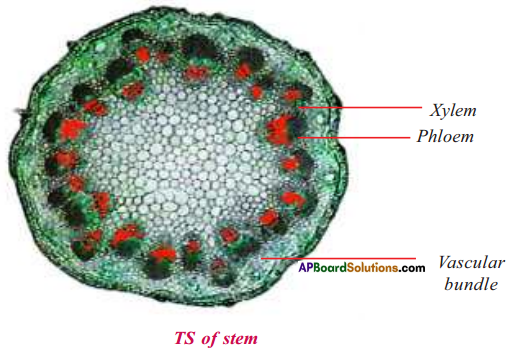
Question 9.
Describe the functions of Meristem, Xylem and Phloem. (AS 1)
Answer:
1. Functions of Meristem:
- It is a dividing meristematic tissue. It divides continuously. The cells formed from meristems later they differentiated as components of other tissues.
- It brings about overall growth and repair.
2. Functions of xylem :
- It conducts water and mineral salts from the root to apical parts of the plant like stems and leaves.
- It gives mechanical support to the plant.
3. Functions of phloem :
Phloem conducts food material from the photosynthetic parts of the plants to other parts.
![]()
Question 10.
While observing internal parts of plants, how do you feel about its structure and functions? (AS 6)
Answer:
- While observing the internal parts of plants I felt that there are different types of tissues to perform various functions.
- For examples xylem and phloem of stem and stomata present on the outer layers of leaf are mend for performing different functions.
- Hence 1 felt that cells are organised from tissues and tissues are organised to perform various functions making the plant alive.
Question 11.
If you want to know more about tissues in plants, what questions you are going to ask? (AS 2)
Answer:
i) Which plant tissue provides both mechanical strength and flexibility?
ii) Which structure protects the plant body against the invasion of disease causing organisms?
iii) What will happen if apical meristem is destroyed or cut?
iv) What is the tissue present in the husk of coconut?
v) Why plants need different types of tissues?
![]()
Question 12.
Collect information about dermal tissues of plants in what way they help to them? Display it on wall magazine. (AS 4)
Answer:
- Dermal tissue usually consists of a single layer of tissues showing variations in the types of cells.
- On the basis of their location and function dermal tissues are studied as three different types epidermis (outer layer), mesodermis (middle layer) and endodermis (inner- most layer).
- Small pores are seen in the epidermis of the leaf called stomata.
- Cells of the roots have long hair like parts, called root hairs.
- Gum is secreted from the dermal layer of gum tree.
- The dermal layer protects the plants from loss of water, mechanical damage and invasion by parasitic and disease causing organisms.
9th Class Biology 2nd Lesson Plant Tissues Activities
Activity – 1
Question 1.
Parts of the plants and their functions.
Fill in the table.
| Function | Name of the parts |
| Absorption of water from soil | |
| Exchange of gases | |
| Photosynthesis | |
| Transpiration | |
| Reproduction |
Answer:
| Function | Name of the parts |
| Absorption of water from soil | Roots |
| Exchange of gases | Stomata of leaf |
| Photosynthesis | Leaf |
| Transpiration | Stomata of leaf |
| Reproduction | Flower |
Activity – 2
Question 2.
How do you observe the cells in onion peel under microscope? Draw and label the diagram. Write your observations.
Answer:
Observing cells in onion peel:
Take a piece of onion peel. Place it on the slide.
Put a drop of water and then a drop of glycerine on it. Gently cover it with a cover slip. Observe it under microscope.

Observations:
- All the cells are similar in shape and structure.
- Intercellular spaces are present.
- Cells are arranged in rows.
- Each cell has cell wall, nucleus and cytoplasm.
Activity – 3
Question 3.
Observe the Cells in a leaf peel.
Answer:
- Take a betel leaf or a Tradescantia leaf.
- Tear it with a single stroke. So that a thin edge be seen at the torn end.
- Observe the thin edge where the leaf has been torn under the microscope in the” same manner as you had observed the onion peel.
Draw a diagram what you have observed and compare it with figure.
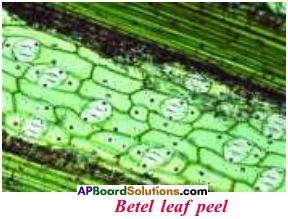
Observations:
We may have observed that the cells are present in groups with certain arrangement. With the help of following activities, we shall try to find out whether these arrangements have special roles to play in the plant body.
a) Are all the cells similar?
Answer:
All the cells are not similar in shape and size.
b) Is there any difference in their arrangement?
Answer:
They are arranged compactly living the small gaps called stomata. Stomata are surrounded by bean shaped cells (Guard cells).
c) What can we infer from the above activities?
Answer:
From the above activities it infers that some of the cells may modify or arranged in a different way to perform specific functions.
d) Have you noticed that the cells are in groups in both the activities?
Answer:
The cells are arranged in groups.
e) Compare and write a note on the arrangements of the cells that you have observed in both of the activities.
Answer:
In the second activity cells are almost of same size and shape but in this activity cells shape and size varies from one another depending on their function.
Activity – 4
Question 4.
How do you observe root tips of onion? Draw the diagram you observe under microscope. Write your observations.
Answer:
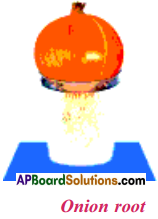
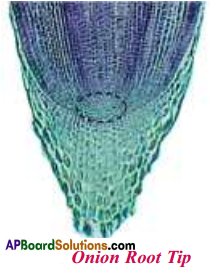
- Take a transparent bottle filled with water. Take the onion bulb slightly larger than the mouth of the bottle.
- Put the onion bulb on the mouth of the bottle.
- Observe the growth of roots for few days till they grow to nearly an inch.
- Take the onion out and cut some of the root tips.
- Take an onion root tip. Place it on the slide. Put a drop of water and then a drop of glycerin on it.
- Cover it with a cover slip. Put the 2-3 layer of filter paper on the cover slip.
- Tap the cover slip gently press with the blunt end of the needle or brush to spread the material.
- Observe under the microscope.
Observations:
- All the cells are not similar in shape and structure.
- Cells are arranged in rows.
- Meristems are present below the root cap.
Activity – 5
Question 5.
Observe the roots of onion which had been cut off? Write your findings.
Answer:
- Take the onion and cut the end of the roots. Mark the cut end of roots with a permanent marker.
- Put the onion bulb on the mouth of the bottle.
- Leave the set up aside at least four to five days.
- Take care that there is enough water in the glass so that the roots are submerged.

Observations :
- By removing the tip of the onion root, having a particular arrangement of cells, the growth of the root in length is stopped.
- Cells are present in groups.
Activity – 6
Question 6.
Write down the arrangement of cells in the given table :
Answer:
| Arrangement of the cells (Tissues) | Shoot tip | Root tip |
| 1. At the tip | Apical meristems are present. | Meristems below the root cap are present. |
| 2. At the lateral side | Lateral meristems are present. | Lateral meristems are present. |
| 3. At the point of branching | Intercalary meristems are present. | Meristems are absent. |
Activity – 7
Question 7.
Observe temporary mount of T.S of Dicot stem under microscope and draw, label the diagram. Write your findings.
Answer:
Observing mount of T.S of Dicot Stem : Prepare a temporary mount of the T.S of dicot stem observe it under microscope.

Findings :
- In the T.S of dicot stem meristematic tissue, vascular tissue, dermal tissue and ground tissue are present.
- All the cells are not similar in shape and structure.
Activity – 8
Question 8.
Observe Rheo leaf peel under microscope. Draw and label the parts. Write your findings.
Answer:
- Take a fresh leaf of Rheo leaf.
- Tear it with a single stroke, so that a thin whitish edge can be seen at torn end.
- Slowly remove it and observe the peel under microscope.

Findings:
- Cells are structurally similar. They are compactly arranged without intercellular.
- It is the dermal tissue of the plant.
- It has an stomatal opening.
Activity – 9
Question 9.
Observe some tissues.
Answer:
Take permanent slides of Chlorenchyma, Arenchyma, Storage Tissue from your laboratory and observe them under the microscope. Find out the characteristics and differences and record them in your notebook.

